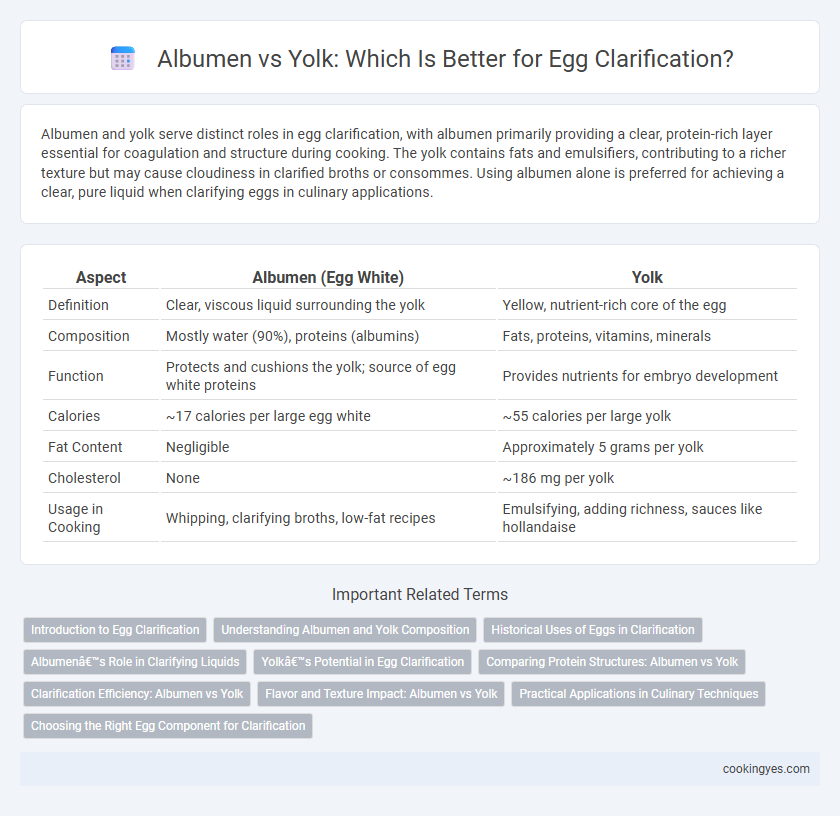Albumen and yolk serve distinct roles in egg clarification, with albumen primarily providing a clear, protein-rich layer essential for coagulation and structure during cooking. The yolk contains fats and emulsifiers, contributing to a richer texture but may cause cloudiness in clarified broths or consommes. Using albumen alone is preferred for achieving a clear, pure liquid when clarifying eggs in culinary applications.
Table of Comparison
| Aspect | Albumen (Egg White) | Yolk |
|---|---|---|
| Definition | Clear, viscous liquid surrounding the yolk | Yellow, nutrient-rich core of the egg |
| Composition | Mostly water (90%), proteins (albumins) | Fats, proteins, vitamins, minerals |
| Function | Protects and cushions the yolk; source of egg white proteins | Provides nutrients for embryo development |
| Calories | ~17 calories per large egg white | ~55 calories per large yolk |
| Fat Content | Negligible | Approximately 5 grams per yolk |
| Cholesterol | None | ~186 mg per yolk |
| Usage in Cooking | Whipping, clarifying broths, low-fat recipes | Emulsifying, adding richness, sauces like hollandaise |
Introduction to Egg Clarification
Egg clarification primarily involves the separation and examination of the albumen and yolk to determine egg quality and freshness. Albumen, the clear, viscous egg white, contains proteins crucial for assessing egg clarity and integrity, while the yolk houses fats and nutrients impacting flavor and nutritional value. Understanding the distinct properties of albumen and yolk helps optimize egg processing, consumption, and culinary applications.
Understanding Albumen and Yolk Composition
Albumen, the clear egg white, consists primarily of water (about 90%) and proteins such as ovalbumin, which contribute to its viscosity and protective function. Yolk contains approximately 50% water, but its composition is rich in lipids, including triglycerides and phospholipids, along with essential vitamins and minerals that support embryo development. Understanding the distinct protein and nutrient profiles of albumen and yolk is crucial for applications in food science and nutrition.
Historical Uses of Eggs in Clarification
Historically, egg albumen has been predominantly used in wine and broth clarification due to its protein structure that binds impurities and sediments effectively. Egg yolk, richer in fats and emulsifiers, was traditionally less favored but occasionally applied in certain culinary clarifications to improve texture and richness. The dual roles of albumen and yolk in clarification highlight the egg's versatile protein and lipid components crucial in traditional food and beverage refinement processes.
Albumen’s Role in Clarifying Liquids
Albumen, the clear protein-rich part of an egg white, plays a crucial role in clarifying liquids by coagulating and trapping impurities during heating. This coagulation process helps remove suspended particles, resulting in a clearer and more refined liquid. In contrast, yolk contains fats and emulsifiers that do not contribute to liquid clarification in the same way as albumen.
Yolk’s Potential in Egg Clarification
Yolk contains lipoproteins that effectively trap suspended particles, making it a powerful agent for egg clarification in culinary and scientific applications. Its emulsifying properties enhance the stability and transparency of liquids, widely utilized in clarifying broths and wines. Compared to albumen, yolk's unique molecular composition offers superior clarity and richness in texture, optimizing the clarification process.
Comparing Protein Structures: Albumen vs Yolk
The albumen, or egg white, primarily consists of water and proteins such as ovalbumin, ovotransferrin, and lysozyme, which contribute to its clear, viscous texture and strong foaming properties. In contrast, the yolk contains a complex mixture of lipoproteins and phosphoproteins including livetins and phosvitin, providing a dense, nutrient-rich medium with emulsifying capabilities. These differences in protein structure influence their functional roles, with albumen proteins supporting coagulation and foam stability, while yolk proteins enhance emulsification and nutrient delivery.
Clarification Efficiency: Albumen vs Yolk
Albumen, composed mainly of water and proteins, exhibits higher clarification efficiency due to its ability to form a clear gel when heated, effectively trapping impurities and improving transparency. Yolk, rich in lipids and emulsifiers like lecithin, tends to produce a more opaque solution with lower clarification efficiency since fats interfere with clarity. Studies indicate that albumen-based clarification achieves greater turbidity reduction compared to yolk, making it preferable in processes requiring enhanced visual purity.
Flavor and Texture Impact: Albumen vs Yolk
Albumen, the egg white, contributes a delicate, neutral flavor and a firm, slightly rubbery texture when cooked, providing structure in recipes such as meringues and souffles. Yolk offers a rich, creamy taste with a smooth, velvety texture, enhancing moisture and adding depth to custards, sauces, and baked goods. The balance between albumen and yolk determines the overall mouthfeel and flavor complexity in culinary applications.
Practical Applications in Culinary Techniques
Albumen, the egg white, provides structure and moisture in recipes such as meringues and souffles, while yolk adds richness, emulsification, and color, essential for sauces like hollandaise and custards. Understanding the distinct protein and fat content in albumen and yolk allows chefs to manipulate texture and flavor, optimizing results in baking, emulsification, and binding. Practical culinary applications rely on separating or combining these components to tailor the final consistency and mouthfeel of dishes.
Choosing the Right Egg Component for Clarification
Albumen, or egg white, is predominantly used for clarification due to its high protein content, which coagulates and traps impurities effectively in broths and consommes. Yolk, rich in fats and emulsifiers, contributes a richer texture and flavor but is less effective for clear liquid clarification. Selecting albumen ensures clearer results in culinary applications where transparency and purity are essential.
Albumen vs Yolk for egg clarification Infographic

 cookingyes.com
cookingyes.com